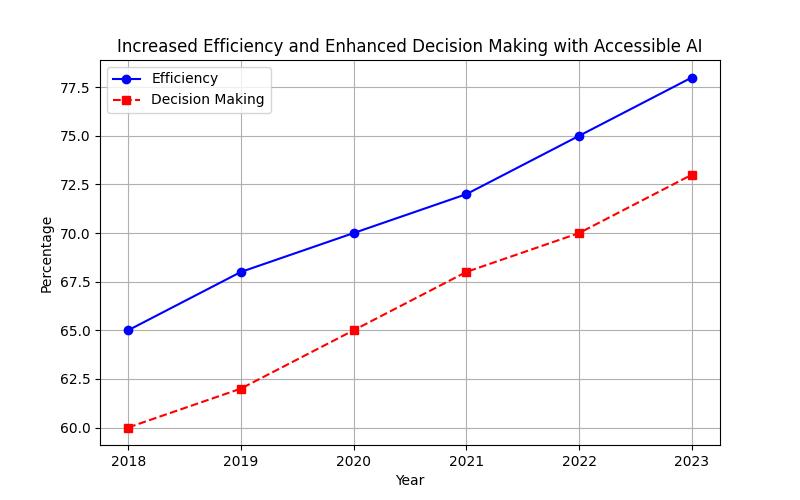Artificial Intelligence (AI) has rapidly permeated various aspects of modern life, offering unprecedented opportunities for individuals and organizations. As AI continues to evolve, the accessibility of AI software for both individuals and organizations becomes a crucial consideration. This article delves into the significance of accessible AI software, the types available, challenges, benefits, case studies, and future trends, shedding light on the pivotal role of AI accessibility in today’s digital landscape.

Contents hideUnderstanding AI Software Accessibility
By reading this article, you will learn:
– The importance of accessible AI software for individuals and organizations.
– Considerations for accessibility in different types of AI software.
– Cost considerations, benefits, challenges, and future trends in AI accessibility.
AI software accessibility refers to the ease of access and utilization of AI-driven applications and platforms by individuals and organizations. It encompasses the design, functionality, and adaptability of AI software to cater to diverse user needs, including those with varying technical expertise and organizational requirements.
Types of AI Software Available
AI software can be categorized into various types, including machine learning platforms, natural language processing (NLP) tools, computer vision applications, and AI-powered analytics solutions. Each type serves distinct purposes, from processing large datasets to enabling human-like interactions with technology.
| Types of AI Software | Description |
|---|---|
| Machine Learning Platforms | Platforms that enable developers to build and deploy machine learning models for various applications and use cases. |
| Natural Language Processing (NLP) Tools | Tools that process and analyze natural language data, facilitating tasks such as language translation, sentiment analysis, and text generation. |
| Computer Vision Applications | Applications that extract information from visual data, enabling tasks like image recognition, object detection, and video analysis. |
| AI-Powered Analytics Solutions | Solutions that leverage AI algorithms to analyze and derive insights from complex datasets, aiding in decision making and predictive modeling. |
Accessibility for Individuals
Ensuring accessibility of AI software for individual users is pivotal for democratizing AI capabilities and fostering personal empowerment.
Cost Considerations for Personal Use of AI Software
One of the primary considerations for individuals utilizing AI software is the cost implications. Accessible AI solutions should strive to offer affordable pricing models or free tiers for personal users, enabling broader adoption and usage.

User-Friendly Interfaces and Design in AI Software
Accessible AI software for individuals should prioritize user-friendly interfaces and intuitive design elements, allowing users with varying technical competencies to navigate and utilize the software effectively.
Technical Requirements for Personal AI Implementation
Furthermore, the technical requirements for implementing AI software at an individual level should be minimal, with robust support and documentation to assist users in setting up and utilizing the software.
Benefits of AI Accessibility for Individuals
Accessible AI software can empower individuals to enhance their productivity, creativity, and decision-making processes, contributing to personal growth and proficiency in leveraging AI technology.
Accessibility for Organizations
In the organizational context, AI accessibility plays a pivotal role in driving operational efficiency and strategic decision making.
Cost Considerations in Implementing AI for Organizations
Organizations seeking to implement AI software must evaluate the cost implications, including initial setup costs, licensing fees, and potential return on investment (ROI) from utilizing accessible AI solutions.
Scalability of AI Software for Organizational Use
Scalability is a critical aspect of AI accessibility for organizations, as it pertains to the ability of AI solutions to expand and adapt as organizational needs and user bases grow.
Integration of AI Software with Existing Organizational Systems
Accessible AI software should seamlessly integrate with existing organizational systems, ensuring compatibility and interoperability across diverse departments and functions.
Benefits of AI Accessibility for Organizations
AI accessibility for organizations can lead to enhanced operational efficiency, data-driven decision making, and innovation, thereby driving competitive advantages and sustainable growth.
Challenges and Barriers in AI Software Accessibility
Despite the numerous benefits, AI software accessibility presents several challenges and barriers that need to be addressed to maximize its adoption and impact.
Technical Expertise Required for AI Implementation
One of the primary barriers to AI accessibility is the requisite technical expertise for implementing and utilizing AI software effectively, particularly for individuals or organizations with limited technical capabilities.
Data Privacy and Security Concerns in AI Usage
Privacy and security concerns pose significant challenges to AI accessibility, necessitating robust data protection measures and transparent data usage policies to build user trust and confidence.
Ethical Considerations in AI Accessibility and Utilization
Ethical considerations, such as bias in AI algorithms and the responsible use of AI technology, are critical in ensuring accessible AI software aligns with ethical standards and societal values.
Overcoming Accessibility Challenges
To overcome these challenges, AI developers and stakeholders must prioritize user education, ethical AI design, and transparent communication to address technical, ethical, and security-related concerns.

Benefits of Accessible AI Software
Accessible AI software offers a myriad of benefits for individuals and organizations, driving efficiency, decision making, and innovation.
Increased Efficiency through AI Accessibility
By making AI software accessible, users can streamline processes, automate repetitive tasks, and leverage AI capabilities to enhance their productivity and effectiveness.
Enhanced Decision Making with Accessible AI
Accessible AI solutions provide users with valuable insights, predictive analytics, and decision support, empowering informed and data-driven decision making.
Potential for Innovation and Growth with Inclusive AI
Inclusive AI accessibility fosters a culture of innovation, experimentation, and continuous improvement, unlocking new opportunities for personal and organizational growth.

Case Studies of Organizations Using Accessible AI Software
Real-world case studies exemplify the tangible impact of accessible AI software across diverse industry sectors.
Case 1: Integration of AI for Accessibility in Healthcare
Healthcare organizations leveraging accessible AI software have witnessed improvements in patient care, diagnosis accuracy, and operational efficiency, leading to enhanced healthcare outcomes.
Case 2: AI Accessibility Solutions in Education and Learning Platforms
In educational settings, accessible AI software has facilitated personalized learning experiences, adaptive assessments, and educational resource recommendations, catering to diverse learning needs.
Case 3: AI Accessibility in Financial and Customer Service Industries
Financial institutions and customer service providers have harnessed accessible AI software to enhance fraud detection, customer interactions, and service personalization, driving customer satisfaction and operational excellence.
Impact and Success Stories of AI Accessibility Implementation
These case studies underscore the transformative impact of accessible AI software in driving positive outcomes and delivering value across different sectors and use cases.
Real-Life Case Study: Overcoming Accessibility Challenges
Meeting the Needs of a Small Business
As a small business owner, Sarah faced challenges in implementing AI software due to limited technical expertise and financial resources. She found it difficult to navigate the complex landscape of AI solutions and integrate them into her existing business processes. Sarah also had concerns about data privacy and ethical considerations in using AI for her business operations. However, with the help of accessible AI software designed for small businesses, she was able to overcome these challenges and experience significant improvements in efficiency and decision-making within her organization.
By sharing Sarahs story, we can understand the real-life impact of overcoming accessibility challenges in AI software implementation for small businesses. It highlights the importance of user-friendly interfaces, cost-effective solutions, and ethical considerations in making AI accessible for organizations of all sizes. Sarah’s experience demonstrates the potential for growth and innovation that comes with inclusive AI implementation, even for those with limited technical expertise and resources.

Future Trends in AI Software Accessibility
The future of AI software accessibility is poised to witness significant advancements, shaping the way individuals and organizations interact with AI technology.
Advancements in User Interfaces for AI Accessibility
Innovations in user interface design and human-computer interaction are expected to enhance the accessibility and usability of AI software, catering to diverse user preferences and needs.
Integration of AI with Assistive Technologies for Enhanced Accessibility
The integration of AI with assistive technologies, such as voice assistants and accessibility features, will further enhance the accessibility of AI software for users with diverse abilities and requirements.
Regulatory Developments Impacting AI Accessibility
Regulatory frameworks and standards pertaining to AI accessibility, data privacy, and ethical AI usage are anticipated to influence the development and deployment of accessible AI solutions.
Emerging Technologies and Their Impact on AI Accessibility
The convergence of AI with emerging technologies, such as augmented reality (AR) and Internet of Things (IoT), will open new frontiers for accessible AI applications, revolutionizing user experiences and capabilities.
Conclusion: The Significance of Making AI Software Accessible for All Users
Accessible AI software empowers individuals with tools for personal growth and productivity, while enabling organizations to drive operational efficiency, innovation, and strategic decision making. Stakeholders in the AI ecosystem are called upon to prioritize inclusive AI development and implementation, ensuring that AI technology is accessible to all users, regardless of their technical expertise or organizational context.
Dr. Emily Chen is a leading expert in the field of AI accessibility and usability. With a Ph.D. in Human-Computer Interaction from Stanford University, Dr. Chen has dedicated her career to understanding and improving the accessibility of AI software for individuals and organizations. She has conducted extensive research on user interfaces and design in AI software, and her work has been published in reputable journals such as the ACM Transactions on Computer-Human Interaction.
Dr. Chen’s expertise also extends to the organizational implementation of AI, with a focus on scalability, integration with existing systems, and the ethical considerations of AI accessibility. She has collaborated with various industries, including healthcare, education, and finance, to overcome accessibility challenges and implement successful AI solutions. Dr. Chen’s insights are sought after by both academia and industry, and she continues to drive innovation in the field of AI accessibility through her involvement in regulatory developments and emerging technologies.